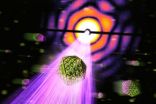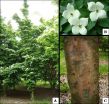Clues to trees' salt tolerance found in native habitat, leaf traits
Canyon maple shows promise for Intermountain West landscapes irrigated with reclaimed water
2014-11-17
(Press-News.org) LOGAN, UT - Urban landscape plants are often subjected to environmental conditions well beyond those of their native habitat. Differences in precipitation, along with stress caused by increased salinity resulting from irrigation with brackish reclaimed water, can have devastating impacts on trees and plants. Use of salt-tolerant species and implementation of proper management strategies can reduce the incidence of plant stress and loss. Researchers in Utah looked to plants' native habitats for ways to identify salt tolerance among tree species used in urban landscapes in the arid to semiarid areas of the Intermountain West.
"We compared salt tolerance of two closely related maple species: canyon maple (Acer grandidentatum) and bigleaf maple (Acer macrophyllum), the western relatives of the sugar maple," explained corresponding author Nisa Leksungnoen, from the Department of Plants, Soils, and Climate at Utah State University. "Our aim was to assess the degree that salt tolerance could be inferred from native habitat and leaf traits and so suggest de facto salt tolerance screening of other regionally native species for low water, salt-affected landscapes," Leksungnoen said.
The scientists compared the two maples to Eucalyptus camaldulensis (red gum), an Australian tree native to saline bottomlands that features evergreen foliage and documented salt and drought tolerance. To assess growth and appearance performance in landscapes, the research focused on measures of leaf damage, gas exchange, and hydric behaviors that respond rapidly to salinity. The results of the study were published in HortScience.
The two maple species and the eucalyptus were subjected to five salinity treatment levels. The scientists measured leaf damage, stomatal conductance and leaf water potential, and photosynthesis. "Eucalyptus showed a key salt-tolerance mechanism by excluding salts from uptake, whereas the two maple species did not," said Leksungnoen. Results also indicated that canyon maple was more resistant to leaf damage than bigleaf maple, but more affected at higher salt concentration than eucalyptus. Eucalyptus leaf area was unaffected by any salinity treatment with no signs of damage on any leaf at any salinity level; in comparison, both maple species exhibited leaf damage and margin burn at different levels of salinity.
Eucalyptus and bigleaf maple also edged canyon maple in terms of gas exchange and water relations. Canyon maple was intermediate between eucalyptus and bigleaf maple in terms of hydric behavior, the extent that internal water potential varies with soil and atmospheric water deficits.
The researchers inferred that canyon maple salt tolerance arose from the tree's native Intermountain West semiarid woodland habitat, which is characterized by seasonal soil drying. "Canyon maple's tolerance is in contrast to bigleaf maple's salt riparian habitat where seasonal soil drying is rare enough to not induce any level of salt tolerance," they noted. "Eucalyptus from a wet-saline habitat then frames canyon maple with a much higher level of salt tolerance in leaf appearance, gas exchange, and hydric behavior."
"Our results suggest that canyon maple can be used in Intermountain West urban landscapes that are irrigated with reclaimed water with electrical conductivities classified as moderate or less, assuming sufficient leaching fraction and minimal foliar interception of overhead irrigation water, because salt on leaves is more damaging than salt-affected soil in hot, high evaporative demand climates such as the United States Intermountain West region," the authors said.
INFORMATION:
The complete study and abstract are available on the ASHS HortScience electronic journal web site: http://hortsci.ashspublications.org/content/49/9/1194.abstract
Founded in 1903, the American Society for Horticultural Science (ASHS) is the largest organization dedicated to advancing all facets of horticultural research, education, and application. More information at ashs.org
ELSE PRESS RELEASES FROM THIS DATE:
2014-11-17
An international team of scientists led by Uppsala University has developed a high-throughput method of imaging biological particles using an X-ray laser. The images show projections of the carboxysome particle, a delicate and tiny cell compartment in photosynthetic bacteria.
The experiment, described in a paper published today in the scientific journal Nature Photonics, represents a major milestone for studies of individual biological structures using X-ray lasers. The technique paves the way for 3D imaging of parts of the cell, and even small viruses, to develop a ...
2014-11-17
November 17, 2014 - A growing body of research evidence shows that complementary and alternative medicine (CAM) has health benefits for US military veterans and active duty personnel, according to a special December supplement to Medical Care. The journal is published by Lippincott Williams & Wilkins, a part of Wolters Kluwer Health.
The special issue presents new studies and commentaries on the benefits and increasing use of CAM techniques in the Veterans Health Administration (VHA) and other military health settings. "The papers in this supplement represent promising ...
2014-11-17
Fatigue, increased irritability, and feeling demoralized, may raise a healthy man or woman's risk of first-time cardiovascular disease by 36 percent, according to a study led by researchers at Mount Sinai St. Luke's and Mount Sinai Roosevelt hospitals presented on Nov. 17 at the American Heart Association's Scientific Sessions 2014 in Chicago, IL.
The combination of fatigue, increased irritability, and feeling demoralized is medically known as vital exhaustion. In their study, Mount Sinai researchers found that vital exhaustion was associated with a dramatic increase ...
2014-11-17
Fragile X syndrome (FXS) is the most common cause of inherited intellectual disability (ID), as well as the most frequent monogenic cause of autism spectrum disorders (ASD). FXS is caused by the absence or incorrect production of the protein FMRP (Fragile X Mental Retardation Protein). Scientists at VIB and KU Leuven (Belgium), in collaboration with Tor Vergata University (Italy) and VU University of Amsterdam (The Netherlands) have pinpointed a novel role that FMRP plays during the embryonic development of the brain cortex. The study reveals that the absence of FMRP leads ...
2014-11-17
Researchers from the University of Southampton have developed a new technique to help produce more reliable and robust next generation photonic chips.
Photonic chips made from silicon will play a major role in future optical networks for worldwide data traffic. The high refractive index of silicon makes optical structures the size of a fraction of the diameter of a human hair possible. Squeezing more and more optical structures for light distribution, modulation, detection and routing into smaller chip areas allows for higher data rates at lower fabrication costs.
As ...
2014-11-17
WASHINGTON, DC--Maritime traffic on the world's oceans has increased four-fold over the past 20 years, likely causing more water, air and noise pollution on the open seas, according to a new study quantifying global ship traffic.
The research used satellite data to estimate the number of vessels on the ocean every year between 1992 and 2012. The number of ships traversing the oceans grew by 60 percent between 1992 and 2002. Shipping traffic grew even faster during the second decade of the study, peaking at rate of increase of 10 percent per year in 2011.
Traffic went ...
2014-11-17
We're entering the era of big neuroscience. In a little over a year, the United States, Europe, Japan and Israel have launched brain research projects with big budgets and bold ambitions. Several other countries are expected to follow suit. But what has propelled neuroscience to the vanguard, and what impact will these initiatives have on the field?
Leaders from three of these projects--the U.S. BRAIN Initiative, Europe's Human Brain Project and Japan's Brain/MINDS--discussed these and other questions ahead of this week's special session on global brain initiatives at ...
2014-11-17
KNOXVILLE, TN -- In the nursery and landscape industries, flowering dogwood (Cornus florida), kousa dogwood (Cornus kousa), and their hybrids are the most popular and economically significant members of the genus Cornus. The deciduous trees are highly valued for their spring display of pink, red, or white bracts, brilliant red fall foliage, and exfoliating bark. In the United States alone, retail and wholesale sales of dogwoods account for more than $30 million dollars annually.
In the past, flowering dogwoods were severely affected by dogwood anthracnose and powdery ...
2014-11-17
Cambridge, Mass. - November 17, 2014 - A vast majority of scientists believe that the Earth is warming at an unprecedented rate and that human activity is almost certainly the dominant cause. But on the topics of response and mitigation, there is far less consensus.
One of the most controversial propositions for slowing the increase in temperatures here on Earth is to manipulate the atmosphere above. Specifically, some scientists believe it should be possible to offset the warming effect of greenhouses gases by reflecting more of the sun's energy back into space.
The ...
2014-11-17
This news release is available in German. The Malt1 protein carries out a variety of tasks in immune cells, known as lymphocytes. Among other things, it acts as an enzyme - specifically, a protease - that breaks down messenger substances and thus controls their quantity. Until now it was not known what role the specific protease function plays in the development of immune cells. Several years ago Prof. Jürgen Ruland and his team at TUM's Klinikum rechts der Isar turned their attention to this question.
Blockade as a therapeutic approach
The scientists were ...
LAST 30 PRESS RELEASES:
[Press-News.org] Clues to trees' salt tolerance found in native habitat, leaf traits
Canyon maple shows promise for Intermountain West landscapes irrigated with reclaimed water



